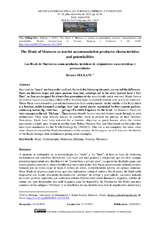| dc.contributor.author | Selkani, Ikrame | |
| dc.date.accessioned | 2022-01-12T11:59:52Z | |
| dc.date.available | 2022-01-12T11:59:52Z | |
| dc.date.issued | 2021 | |
| dc.identifier.issn | 2530-7134 | |
| dc.identifier.uri | http://hdl.handle.net/10396/22312 | |
| dc.description.abstract | Riad and dar ‘house’ are frequently confused, but with the following elements, we can tell the difference. Riads are likewise larger and more spacious than dars, although not to the level “ground floor + first floor”, as they are designed for almost four generations of the same family under one roof. Riads feature an exterior façade comprising a blind wall to 8 meters high, completely neutral, with nearly no windows. These Riads were erected to prevent indiscreet eyes from seeing inside. In the middle of the Riad, there is a fountain, richly decorated in zellige ‘tiles’ and carved plaster, surrounded by four separate gardens, containing lemon, fig, mint trees…, giving off a subtle fragrance for the locals. In Morocco, Riads are very common in the old ‘Médinas’. These houses benefit from a very rich history made through its own architecture. They were initially houses of notables, keen to protect the privacy of their families. Nowadays, Riads have been restored for a touristic objective as guest houses where the visitor encounters a comfy area, frozen in another time. Rabat, Meknes, Fez, and Marrakech are the cities that have been nominated for the World Heritage by UNESCO. This list is not complete, but these cities were chosen to expand the Riad phenomenon in the country. In this paper, we will discover the history of the Riads through their architecture giving some examples. | es_ES |
| dc.description.abstract | A menudo se confunden en la terminología los “riads” y los “dars”, si bien se trata de viviendas tradicionales con sensibles diferencias. Los riads son más grandes y espaciosos que los dars, aunque presentan igualmente una distribución de "planta baja + primer piso", ya que están diseñados para casi cuatro generaciones de la misma familia bajo un mismo techo. Los Riads presentan una fachada exterior formada por un muro ciego de hasta 8 metros de altura, completamente neutro, sin apenas ventanas. Estos Riads se erigieron para evitar que ojos indiscretos vieran el interior. En el centro del Riad suele disponerse una fuente, ricamente decorada con "azulejos" de zellige y yeso tallado, así como rodeada de cuatro jardines separados que contienen árboles frutales tales como limoneros, higueras, árboles de menta, etc. que desprenden una sutil fragancia para los lugareños. En Marruecos, los Riads son muy comunes en las antiguas "Médinas" y se benefician de una historia muy rica de arquitectura autóctona y tradicional. Inicialmente eran casas de notables, deseosos de proteger la intimidad de sus familias. Hoy en día, los Riads han sido restaurados con un objetivo turístico como casas de huéspedes donde el visitante se encuentra con un espacio confortable, a la vez que como sumergido en otra época. Rabat, Meknes, y Fez son las ciudades que han sido nominadas al Patrimonio Mundial por la UNESCO. Esta lista no está completa, pero estas ciudades fueron elegidas para expandir el fenómeno de los Riads en el país. En este artículo descubriremos la historia de los Riads a través de su arquitectura dando algunos ejemplos. | es_ES |
| dc.format.mimetype | application/pdf | es_ES |
| dc.language.iso | en | es_ES |
| dc.publisher | UCOPress | es_ES |
| dc.rights | https://creativecommons.org/licenses/by-nc/4.0/ | es_ES |
| dc.source | Revista Internacional de Turismo, Empresa y Territorio (RITUREM) 5(2), 42-60 (2021) | es_ES |
| dc.subject | Riad | es_ES |
| dc.subject | Architecture | es_ES |
| dc.subject | Morocco | es_ES |
| dc.subject | Médina | es_ES |
| dc.subject | Tourist | es_ES |
| dc.subject | Arquitectura | es_ES |
| dc.subject | Marruecos | es_ES |
| dc.subject | Turismo | es_ES |
| dc.title | The Riads of Morocco as tourist accommodation products: characteristics and potentialities | es_ES |
| dc.title.alternative | Los Riads de Marruecos como productos turísticos de alojamiento: características y potencialidades | es_ES |
| dc.type | info:eu-repo/semantics/article | es_ES |
| dc.relation.publisherversion | http://www.uco.es/ucopress/ojs/index.php/riturem/index | es_ES |
| dc.rights.accessRights | info:eu-repo/semantics/openAccess | es_ES |

